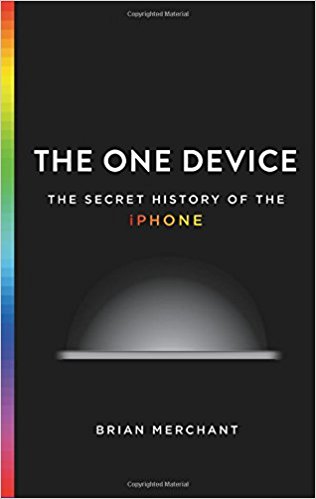You have /5 articles left.
Sign up for a free account or log in.
 The One Device: The Secret History of the iPhone by Brian Merchant
The One Device: The Secret History of the iPhone by Brian Merchant
Published in June of 2017.
The iPhone is ten years old. Can you name a technology that has been more influential in the past decade - and the subsequent smart phones that have followed - than the iPhone?
The One Device tells the story of how the iPhone was conceived and developed. Merchant has two main goals. First, he is determined to demolish the myth that Steve Jobs invented the iPhone. The iPhone, like every other non-linear technological breakthrough, was the product of many minds and many advances. (Both within and outside of Apple).
In giving credit to all the engineers and designers who were critical to the invention of the iPhone, Merchant is not trying to diminish the role of Steve Jobs as leader, curator, visionary, and communicator. Rather, he is trying to make the point that the story of progress and invention is always more complicated than is usually appreciated - and to give credit where credit is due.
The second goal of The One Device is to explain the technologies, materials, and processes that go into the creation of an iPhone. Merchant has an iPhone pulverized and its constituent metals and parts analyzed - and then he heads to Bolivia to understand how some of the minerals that are necessary to create the device are mined.
In an entertaining section of the book, Merchant sneaks into one of the Chinese Foxconn factories to try to watch the iPhone being manufactured. He fails to lay eyes on the actual production lines, but is able to provide a grippingly depressing account of life inside a modern-day Chinese city-sized factory.
Are there lessons from that we can take about the history of the iPhone for the future of higher ed?
The One Device is mostly a story about how innovation within an organization occurs. And truthfully, it may not be a story that we in higher ed want to imitate.
The people who conceived of and designed the iPhone within Apple paid a heavy price. For 2 years a small team of engineers and designers basically moved into a set of labs and offices in Cupertino. Merchant is unsparing in detailing the costs on marriages and health when the work of creating the iPhone became an all consuming endeavor.
Another lesson of The One Device is about how difficult it is to predict the consequences of new technologies. It is easy to forget that when the iPhone launched that Jobs insisted on it being a closed system. There was no app store at launch.
Steve Jobs thought that the killer app of the iPhone was phone calls and visual voice mail. The social media and third party communications apps that have come to dominate the iPhone user experience were never envisioned.
We think that we know where higher ed will go in the next 10 years, but if the decade long history of the iPhone is any example we may end up being surprised.
Finally, there is the whole question of the relationship between mobile computing and educational technology.
The iPhone - and the smart phone - is today our primary interface with digital technology. We carry our phones everywhere. Our phones have become part of us, and many digital industries are now mobile industries.
When and if a similar change, from the computer/browser to the mobile device, will come digital learning remains an unsettled question.
How has digital learning changed in the 10 years since the iPhone emerged?
Can you imagine a technology that might be unleashed today that would have a similar impact by 2027 as the iPhone has had on our lives?
Why has the promised mobile revolution in digital learning seem to have fizzled - or at least not followed a similar trajectory as other now mobile dominant platforms?
What are you reading?




